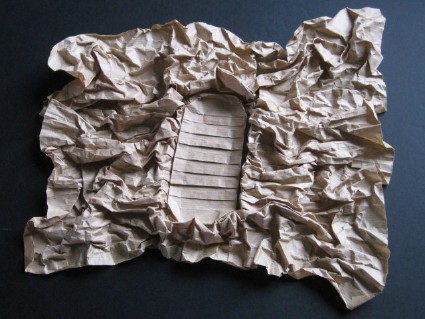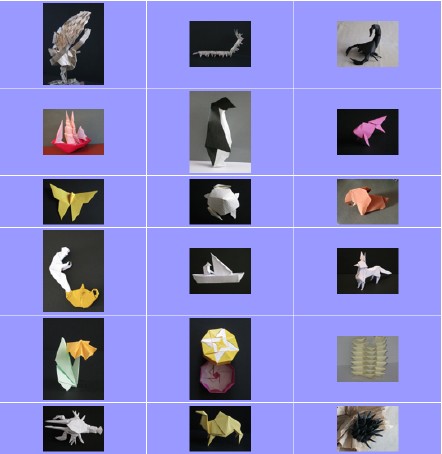
 | Welcome on MOOC-invitation |
|
| New! | An invitation to practice origami | map | Discovery of the world of folding paper From origami to the Art of Folding Paper |
| Back MOOC1 | Journey 2 | Sequence 1 | <--- page 9 | page 1 | page 2---> |
 |
Some steps towards the mastering of paper folding |
| Origami was probably born in China, at the same time as the invention of paper. It arrives in Japan (approximately around 600) thanks to a buddhist monk. First confined in a ceremonial use, origami sees new created models, of geometrical style et more or less symbolic. Paper folding becomes a traditional activity, and spreads out due to the publication of some books such as « Senbazuru Orikata » written by Gido Rokoan in 1797 or the « Kan-no mado », two volumes of a huge encyclopaedia published in 1845. Later on, only a few innovations appear in paper folding, the weight of tradition stifling any originality. On the other hand, the descriptions of foldings were written in ancient japanese. Only a few people are able to read and understand them, and the spreading of this practice cannot occur. One must wait upon the years 1950 so that a revolution, prompted by the Japanese Master Akira Yoshizawa blew up. This folder, designer of some 60.000 models, disrupted the art of folding paper, shook up all traditional taboos. His first published monography, « Atarashi Origami Geijutsu » (The New Art of Origami), is published in 1954. In this word, he introduced the Yoshizawa–Randlett notation system for describing the origami folds. This system has become a standard for most of the folders. From this moment, diagrams became readable by anybody, no matter the spoken language. Origami practice becomes international and begins to spread out. A few names of the creators responsible for this propagation in Europe: Samuel Randlett , Robert Harbin , Lilian Oppenheimer, Ligia Montoya , Patricia Crawford , Elias Neal , Peter Engel et John Montroll sont de fervents propagateurs en Europe et aux Etats-Unis. Depuis le Japon, Kunihiro Kasahara , Toshie Takahama et Tomoko Fuse disseminate new folding techniques through a number of books. Around 1960, Emmanuel Mooser has been the first to use the box pleating technique, to create his famous train. This technqiue will shake up the world of origami, because of the numerous possibilities which were offered: the ability to create as many flaps as necessary to represent animals, persons or objects. A true struggle via insects design began, by way of legs, antennae, anatomical details. It is the time of the great foldings of Robert J. Lang and Satoshi Kamiya (amongst others). At the same time, some folders began to study the mathematical foundations of paper folding. Their works allow us to better understand what can be done, and what cannot be done. Robert J. Lang gathers all this knowledge and publishes in 2003 « Origami Design Secrets - Mathematical Methods for an Ancient Art », which includes, for instance, a method of creating models by using notions of circles, rivers, grafting and other techniques. This publication led to a sudden development of origami, particularly through the development of computer aided design software. One result has been a systematic use of crease patterns (CP), graphs of the most importants folds to mae to obtain a base, which will be later on as modelled as can be. Today, crease patterns have a tendency to replace diagrams. Today, the « complex » foldings of this period are common practice and books published these days are filled with them ( for instance the one by Shuki Kato or by Makoto Yamaguchi ). In order to close this survey, we must quote, beside classical inspiration sources such as the living world or ornamental objects, the development of two origami branches: - the « kusudamas », modular foldings based upon mathematical polyhedra. New creations are shown every day! - the tesselations, whose discovery is attributed to Shuzo Fujimoto , great folder whom creativity is still to be entirely put into light. Improvements achieved in the domain of paper folding since the revolution due to the works of Akira Yoshizawa around 1950 have allowed us to create works which were, strictly speaking, unthinkable at that moment. This phenomenon continues, et what is created today is far from what will be folded tomorrow or the day after tomorrow. All things considered, folding paper is undergoing an evolution as strong as the one of computer science: - technical level higher and higher but mastered thanks to the associated mathematical concepts, - variety of inspiration sources due to the globalization of paper folding, - boldness of designers aiming at more and more crazy projects. We went from the age of origami to the age of the Art of paper folding. You can consult a list of French folders at the page Origami de France . |
21 photo(s)